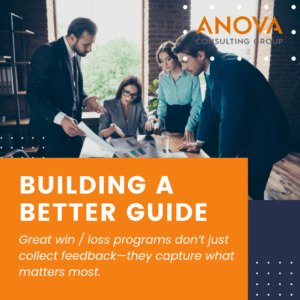
Thursday, May 1, 2025
 Part 2: Designing the Right Interview Guide
Part 2: Designing the Right Interview GuideCritical to win / loss program success is capturing the right information. Win / loss is a powerful tool in part because of the breadth of customer feedback it can collect. It is normal for feedback to cover sales, product, pricing, services, brand / market positioning, and of course competitive comparisons.
In a perfect world companies would be able to collect as much feedback as possible across all these areas in each interview, however respondents don’t have unlimited time to give. This makes interview guide design really an optimization exercise.
To maximize a program’s value, questions should be aligned to the biggest areas of focus that were identified by stakeholders in the buy-in stage. This will ensure that above all else, feedback is maximized in those influential areas that are most responsible for driving wins and losses.
Beyond concentrating on those critical areas of focus, interview guide design should also achieve a balance between the following types of questions:
One last thing to consider: the interview guides shouldn’t be set in stone. As you collect feedback and/or your business priorities change, adapt the guide so you are constantly optimizing your feedback loop.
Ultimately, win / loss interview guides can take all shapes and forms. With a little thought into areas you want to focus on, and a balanced approach for collecting feedback, the guide can be a vital tool for collecting actionable feedback.